Influence of Si Content on the Microstructure and Properties of Hydrogenated Amorphous Carbon Films Deposited by Magnetron Sputtering Technique
Abstract
1. Introduction
2. Experimental
2.1. Film Deposition
2.2. Film Characterization
3. Results and Discussion
4. Conclusions
Author Contributions
Funding
Institutional Review Board Statement
Informed Consent Statement
Data Availability Statement
Conflicts of Interest
References
- Zhu, S.; Cheng, J.; Qiao, Z.; Yang, J. High temperature solid-lubricating materials: A review. Tribol. Int. 2019, 133, 206–223. [Google Scholar] [CrossRef]
- Sliney, H.E. Solid lubricant materials for high temperatures—A review. Tribol. Int. 1982, 15, 303–315. [Google Scholar] [CrossRef]
- Sarkar, M.; Mandal, N. Solid lubricant materials for high temperature application: A review. Mater. Today Proc. 2022, 66, 3762–3768. [Google Scholar] [CrossRef]
- Ni, W.; Cheng, Y.-T.; Weiner, A.M.; Perry, T.A. Tribological behavior of diamond-like-carbon (DLC) coatings against aluminum alloys at elevated temperatures. Surf. Coat. Technol. 2006, 201, 3229–3234. [Google Scholar] [CrossRef]
- Deng, X.; Kousaka, H.; Tokoroyama, T.; Umehara, N. Thermal Stability and High-Temperature Tribological Properties of a-C:H and Si-DLC Deposited by Microwave Sheath Voltage Combination Plasma. Tribol. Online 2013, 8, 257–264. [Google Scholar] [CrossRef]
- Erdemir, A.; Donnet, C. Tribology of Diamond and Diamond-like Carbon Films. In Wear–Materials, Mechanisms and Practice; John Wiley & Sons, Ltd.: Hoboken, NJ, USA, 2005; pp. 191–222. [Google Scholar]
- Liu, H.; Tanaka, A.; Umeda, K. The tribological characteristics of diamond-like carbon films at elevated temperatures. Thin Solid Films 1999, 346, 162–168. [Google Scholar] [CrossRef]
- Bhowmick, S.; Banerji, A.; Khan, M.Z.U.; Lukitsch, M.J.; Alpas, A.T. High temperature tribological behavior of tetrahedral amorphous carbon (ta-C) and fluorinated ta-C coatings against aluminum alloys. Tribol. Int. 2015, 284, 14–25. [Google Scholar] [CrossRef]
- Yu, W.; Huang, W.; Wang, J.; Su, Y.; Long, Q.; Wang, L.; Zhu, L. High-temperature tribological performance of the Si-gradually doped diamond-like carbon film. Vacuum 2021, 191, 110387. [Google Scholar] [CrossRef]
- Vitu, T.; Escudeiro, A.; Polcar, T.; Cavaleiro, A. Sliding properties of Zr-DLC coatings: The effect of tribolayer formation. Surf. Coat. Technol. 2014, 258, 734–745. [Google Scholar] [CrossRef]
- Santiago, J.A.; Fernández-Martínez, I.; Sánchez-López, J.C.; Rojas, T.C.; Wennberg, A.; Bellido-González, V.; Molina-Aldareguia, J.M.; Monclús, M.A.; González-Arrabal, R. Tribomechanical properties of hard Cr-doped DLC coatings deposited by low-frequency HiPIMS. Tribol. Int. 2020, 382, 124899. [Google Scholar] [CrossRef]
- Zheng, J.; Shang, J.; Zhuang, W.; Ding, J.C.; Mei, H.; Yang, Y.; Ran, S. Structural and tribomechanical properties of Cr-DLC films deposited by reactive high power impulse magnetron sputtering. Vacuum 2024, 230, 113611. [Google Scholar] [CrossRef]
- Yu, W.; Huang, W.; Wang, J.; Su, Y.; Gong, X. Further improving the mechanical and high-temperature tribological properties of silicon-doped diamond-like carbon film by tungsten incorporation. Surf. Rev. Lett. 2024, 31, 2450035. [Google Scholar] [CrossRef]
- Zhao, D.; Mei, H.; Ding, J.C.; Cheng, Y.; Zhang, L.; Zhang, T.F.; Kwang, H.K.; Zheng, J. Microstructure and properties of Mo doped DLC nanocomposite films deposited by a hybrid sputtering system. Vacuum 2023, 208, 111732. [Google Scholar] [CrossRef]
- Li, X.-W.; Joe, M.-W.; Wang, A.-Y.; Lee, K.-R. Stress reduction of diamond-like carbon by Si incorporation: A molecular dynamics study. Tribol. Int. 2013, 228, S190–S193. [Google Scholar] [CrossRef]
- Sharifahmadian, O.; Pakseresht, A.; Mosas, K.K.A.; Galusek, D.; Wang, L.; Liu, Y.; Chen, H.; Wang, M.; Zhang, S.; Yan, M.; et al. Doping effects on the tribological performance of diamond-like carbon coatings: A review. J. Mater. Res. Technol. 2023, 27, 7748–7765. [Google Scholar] [CrossRef]
- Zhang, T.F.; Wan, Z.X.; Ding, J.C.; Zhang, S.; Wang, Q.M.; Kim, K.H. Microstructure and high-temperature tribological properties of Si-doped hydrogenated diamond-like carbon films. Appl. Surf. Sci. 2018, 435, 963–973. [Google Scholar] [CrossRef]
- Chen, Y.; Su, F.; Li, Q.; Sun, J.; Lin, S.; Ma, G. Extremely enhanced friction and wear performance of hydrogen-free DLC film at elevated temperatures via Si doping. Tribol. Int. 2024, 199, 109981. [Google Scholar] [CrossRef]
- Wang, L.; Li, H.; Pu, C.; Wang, L.; Wang, J. Elevated temperature tribological properties of a-C:Si films sputtered from SiC target in the presence of C2H2 gas. Mater. Today Commun. 2024, 38, 108226. [Google Scholar] [CrossRef]
- Lu, S.; Duan, F. High Temperature Induced Low Friction and Wear in a-C:Si via Formation of a “H Passivation Layer/a-SiO2/H Passivation Layer” Structure in a Humid Environment. Langmuir 2024, 40, 18078–18088. [Google Scholar] [CrossRef]
- Li, Z.; Xu, M.; Zhang, H.; He, W.; Zhang, G.; Lu, Z. Effect of silicon-doping on the wide-temperature tribological behavior and lubrication mechanism of WC/a-C film. Wear 2023, 516–517, 204614. [Google Scholar] [CrossRef]
- Merkle, A.P.; Erdemir, A.; Eryilmaz, O.L.; Johnson, J.A.; Marks, L.D.; Archard, J.F. Contact and Rubbing of Flat Surfaces. J. Appl. Phys. 1953, 24, 981–988. [Google Scholar]
- Ding, J.C.; Dai, W.; Zhang, T.F.; Zhao, P.; Yun, J.M.; Kim, K.H.; Wang, Q.M.; Kajita, S.; Righi, M.C. Microstructure and properties of Nb-doped diamond-like carbon films deposited by high power impulse magnetron sputtering. Thin Solid Films 2018, 663, 159–167. [Google Scholar] [CrossRef]
- Kim, J.-I.; Jang, J.-W.; Umehara, N.; Jang, Y.-J. Counterpart-dependent friction and wear of hydrogenated tetrahedral amorphous carbon under ultra-high vacuum. Carbon 2025, 238, 120223. [Google Scholar] [CrossRef]
- Ma, Q.; Fu, Y.; Xu, Y.; Ma, T. Achieving superlubricity and high adhesion strength of hydrogenated amorphous carbon film with Al/Cr/Si-doping. Carbon 2023, 215, 118424. [Google Scholar] [CrossRef]
- Ferrari, A.C.; Robertson, J. Resonant Raman spectroscopy of disordered, amorphous, and diamondlike carbon. Phys. Rev. B 2001, 64, 075414. [Google Scholar] [CrossRef]
- Liskiewicz, T.; Yang, J.; Chen, Z.; Yuan, Y.; Chen, Q.; Feng, X.; Qin, L.; Zhang, Y. Tuning C-C sp2/sp3 ratio of DLC films in FCVA system for biomedical application. Bioact. Mater. 2020, 5, 192–200. [Google Scholar]
- Ferrari, A.C.; Robertson, J. Interpretation of Raman spectra of disordered and amorphous carbon. Phys. Rev. B 2000, 61, 14095–14107. [Google Scholar] [CrossRef]
- Jantschner, O.; Field, S.K.; Holec, D.; Fian, A.; Music, D.; Schneider, J.M.; Zorn, K.; Mitterer, C. Origin of temperature-induced low friction of sputtered Si-containing amorphous carbon coatings. Acta Mater. 2015, 82, 437–446. [Google Scholar] [CrossRef]
- Dong, Y.; Zhao, Y.; Li, J.; Chen, J.; Zheng, J.; Sun, D.; Zhang, S.; Wang, S. Super-hard and well-tough (TiZrVCrCoNi)Nx high entropy nitride coatings with biphasic nanocomposite structure. Tribol. Int. 2024, 224, 113110. [Google Scholar] [CrossRef]
- Chen, C.; Xue, P.; Fan, X.; Wang, C.; Diao, D. Friction-induced rapid restructuring of graphene nanocrystallite cap layer at sliding surfaces: Short run-in period. Carbon 2018, 130, 215–221. [Google Scholar] [CrossRef]
- He, F.; Aebersold, R.; Baker, M.S.; Bian, X.; Bo, X.; Chan, D.W.; Chang, C.; Chen, L.; Chen, X.; Chen, Y.-J.; et al. Structure, Mechanical and Tribological Properties of Me-Doped Diamond-like Carbon (DLC) (Me = Al, Ti, or Nb) Hydrogenated Amorphous Carbon Coatings. Coatings 2018, 8, 370. [Google Scholar]
- Tran, N.V.; Righi, M.C. Ab initio insights into the interaction mechanisms between H2, H2O, and O2 molecules with diamond surfaces. Carbon 2022, 487, 497–507. [Google Scholar] [CrossRef]
- Kajita, S.; Righi, M.C. Insigths into the Tribochemistry of Silicon-doped Carbon-Based Films by Ab Initio Analysis of Water–Surface Interactions. Tribol. Lett. 2016, 61, 17. [Google Scholar] [CrossRef]
- Venturi, F. Carbon-based films: A review on mechanical and tribology properties. Mater. Chem. Phys. 2024, 325, 129716. [Google Scholar] [CrossRef]
- Wang, Y.; Gao, K.; Zhang, B.; Wang, Q.; Zhang, J. Structure effects of sp2-rich carbon films under super-low friction contact. Mater. Today Proc. 2018, 137, 49–56. [Google Scholar] [CrossRef]
- Ma, T.-B.; Wang, L.-F.; Hu, Y.-Z.; Li, X.; Wang, H. A shear localization mechanism for lubricity of amorphous carbon materials. Tribol. Int. 2015, 4, 3662. [Google Scholar] [CrossRef]
- Sun, K.; Sun, M.; Chen, C.; Chen, S.; Fan, J.; Diao, D. Structural and tribological behaviours of silicon doped amorphous carbon films. Carbon 2023, 215, 118434. [Google Scholar] [CrossRef]
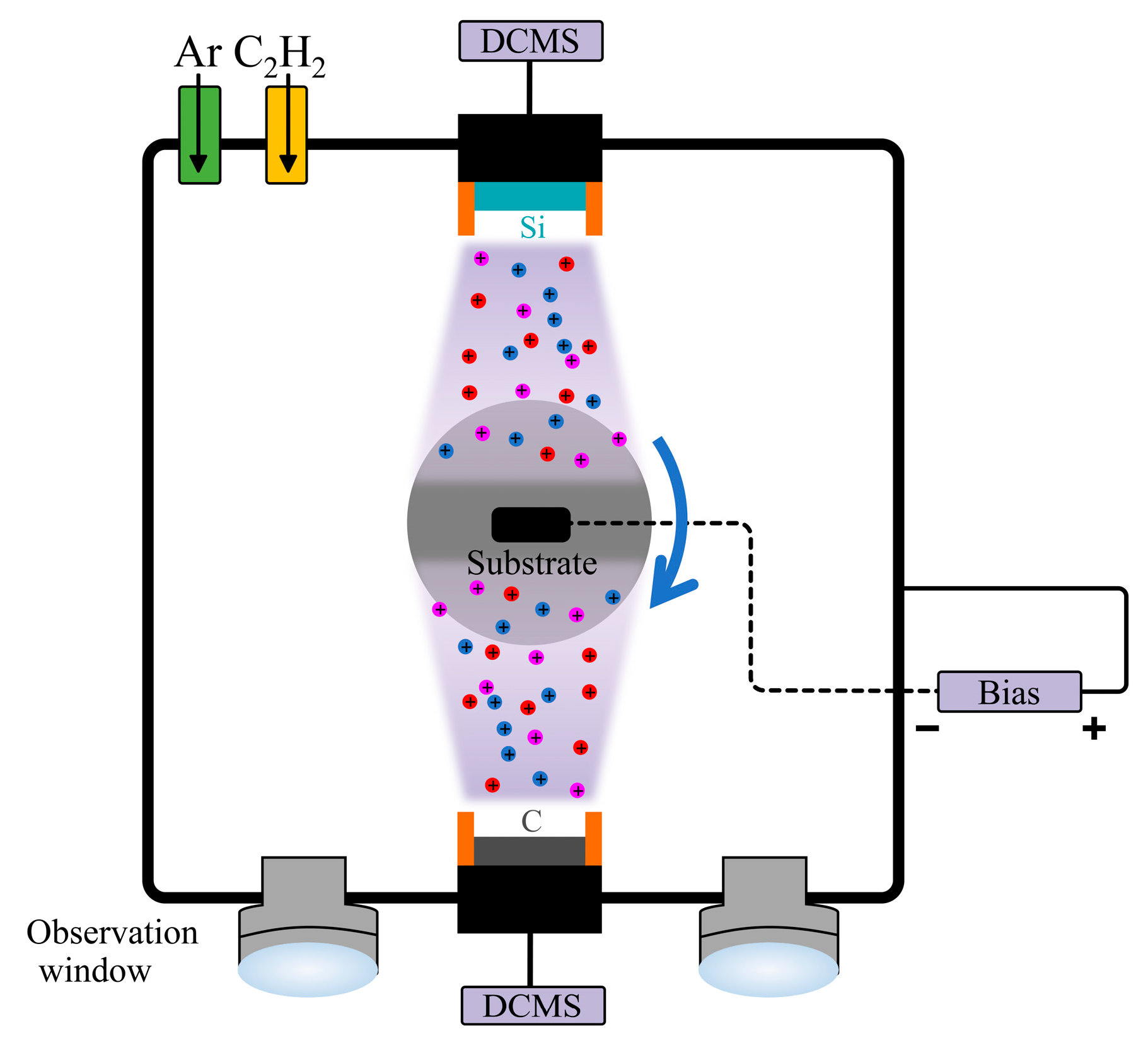
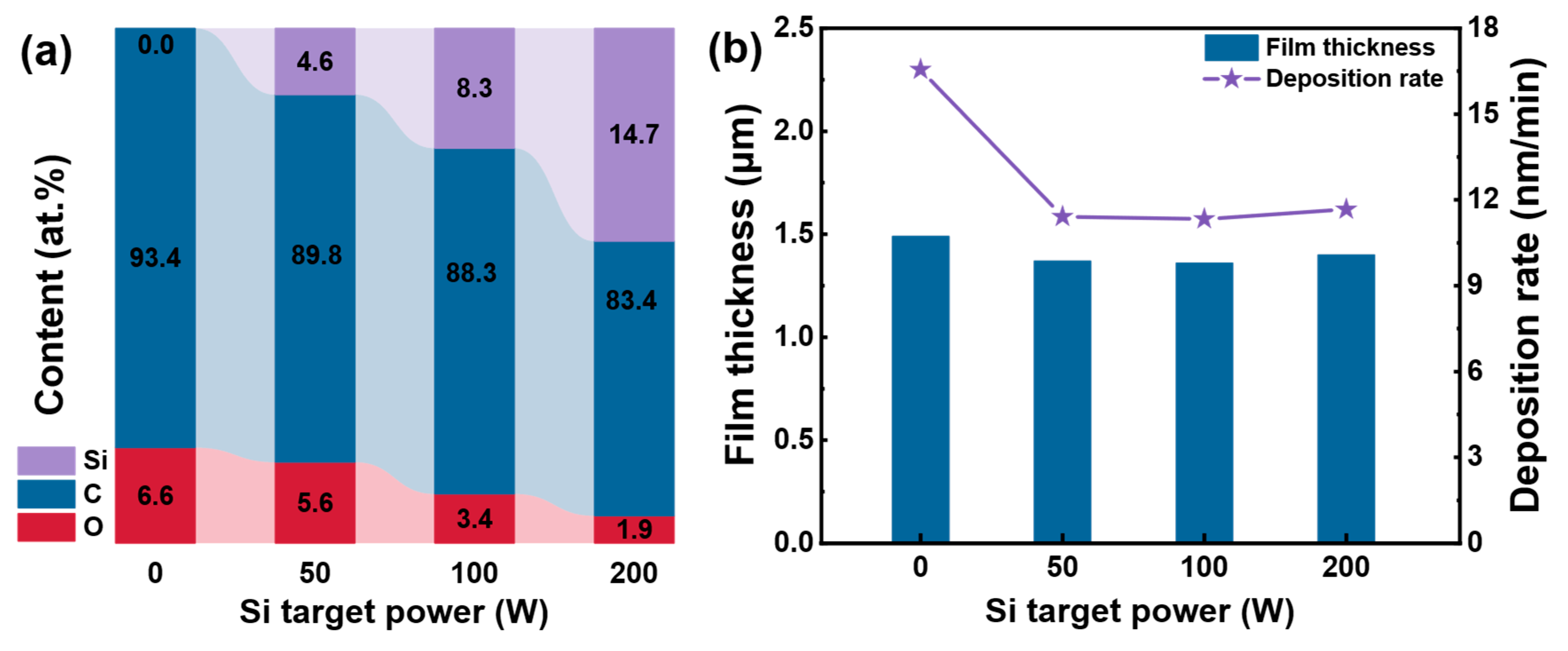

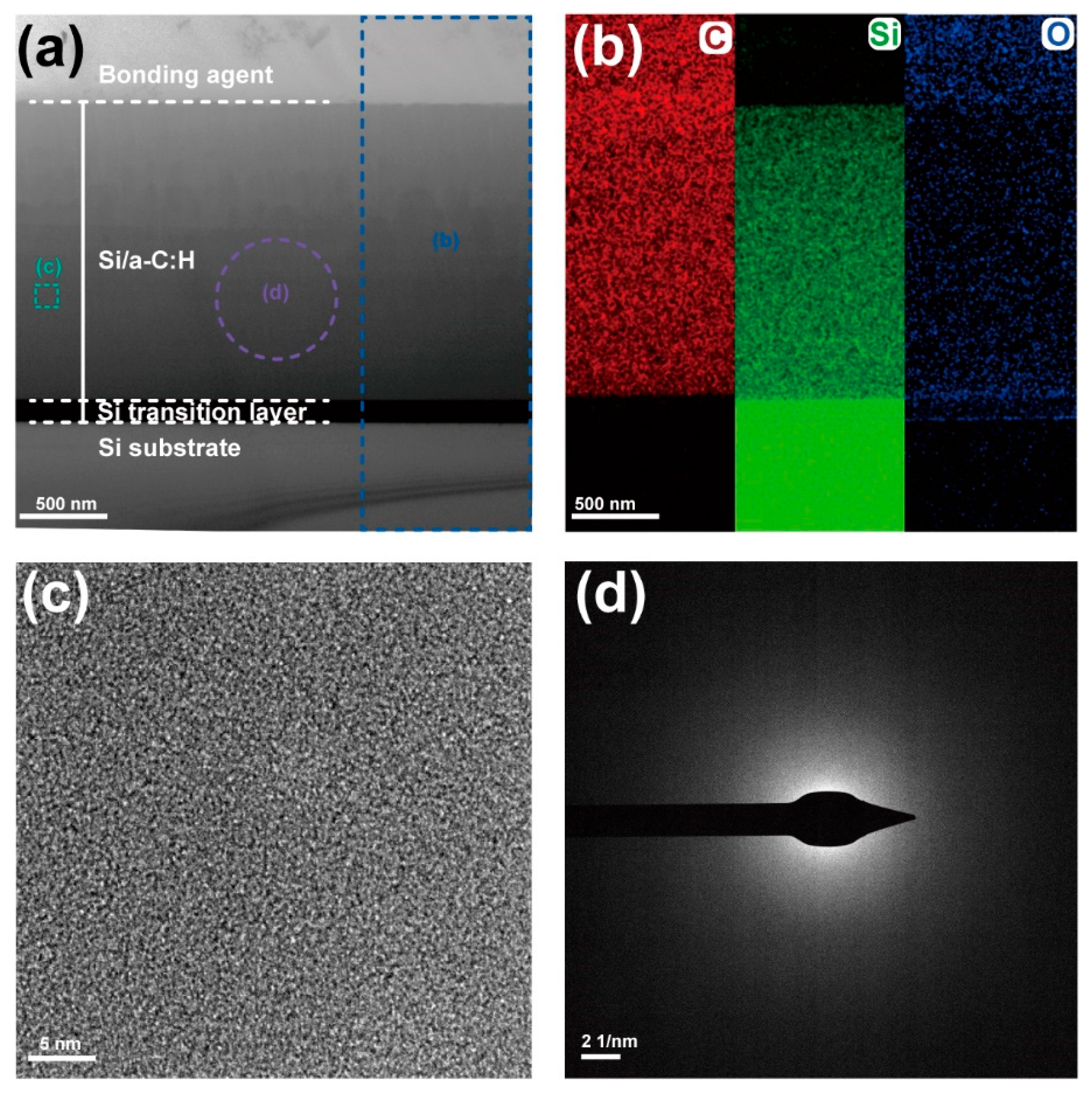


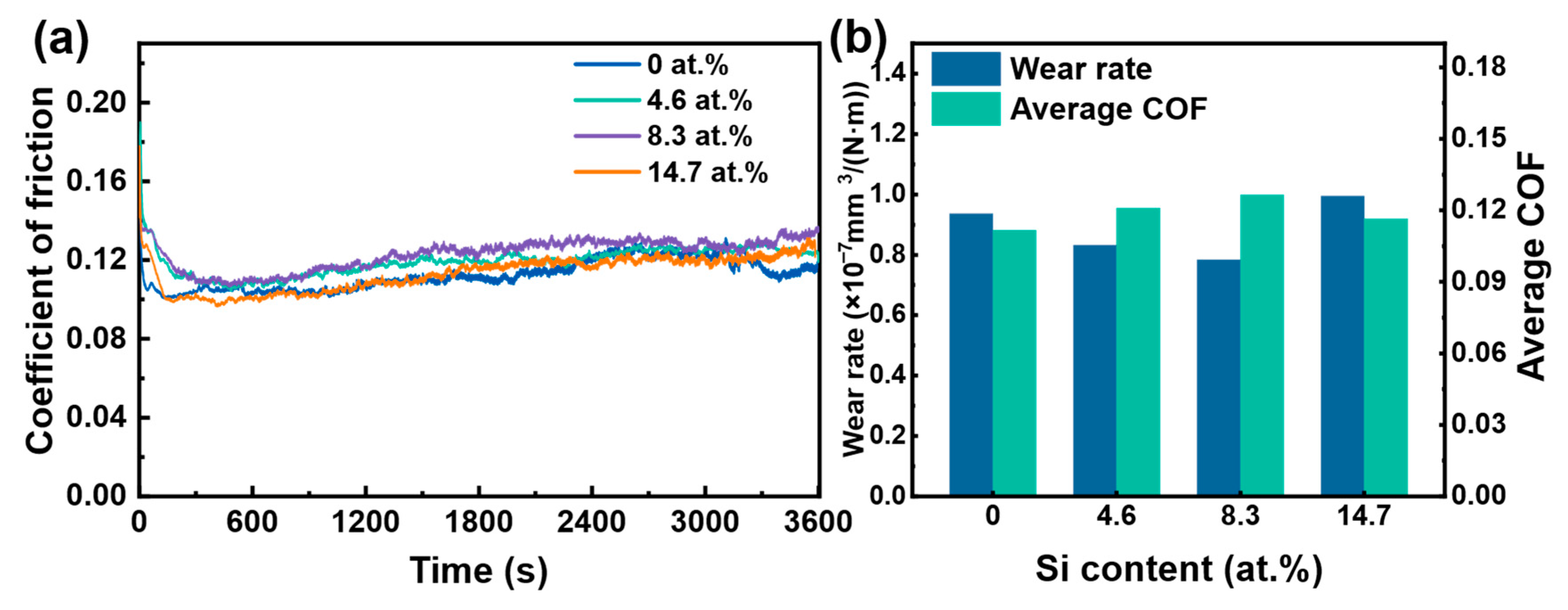
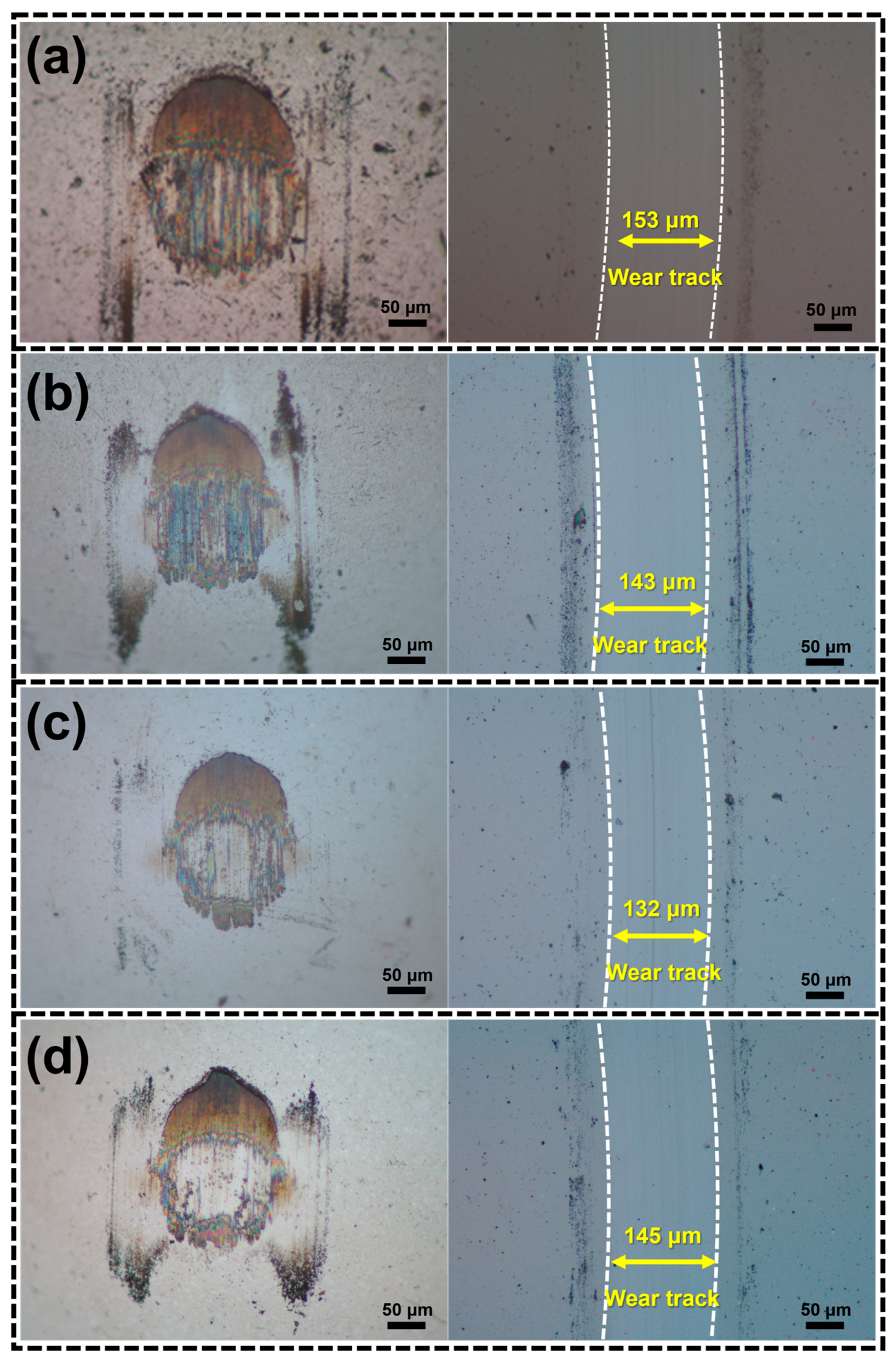
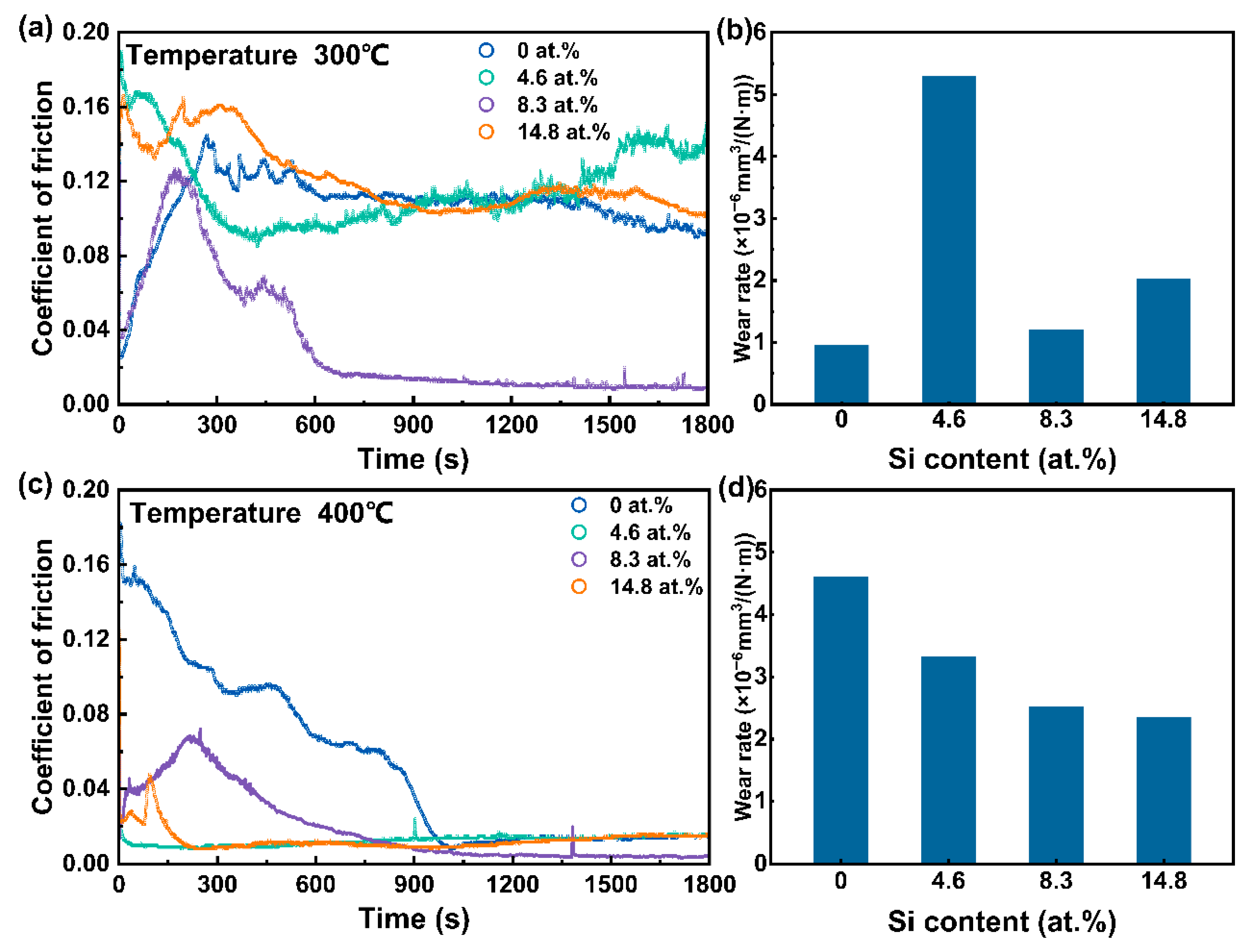
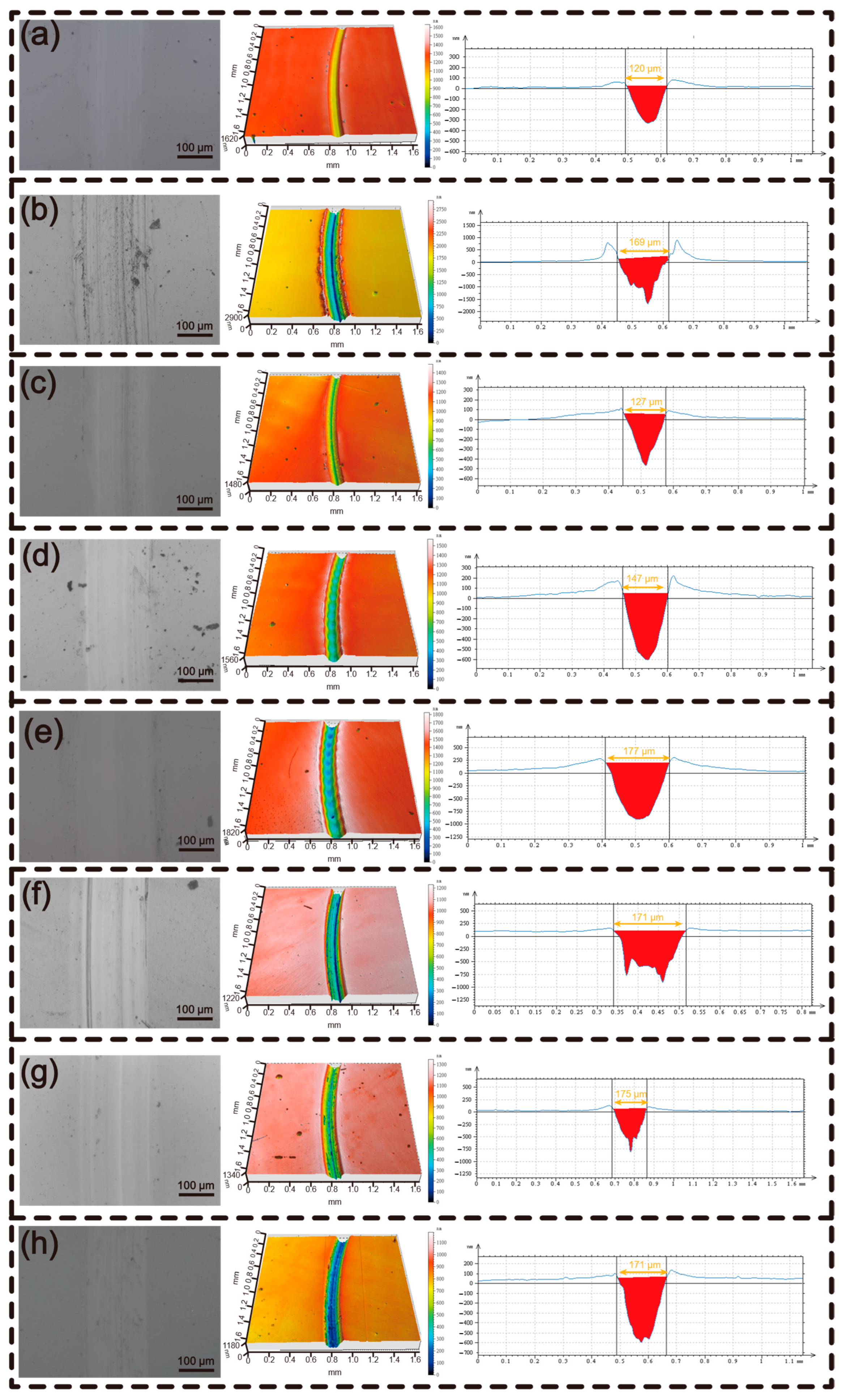
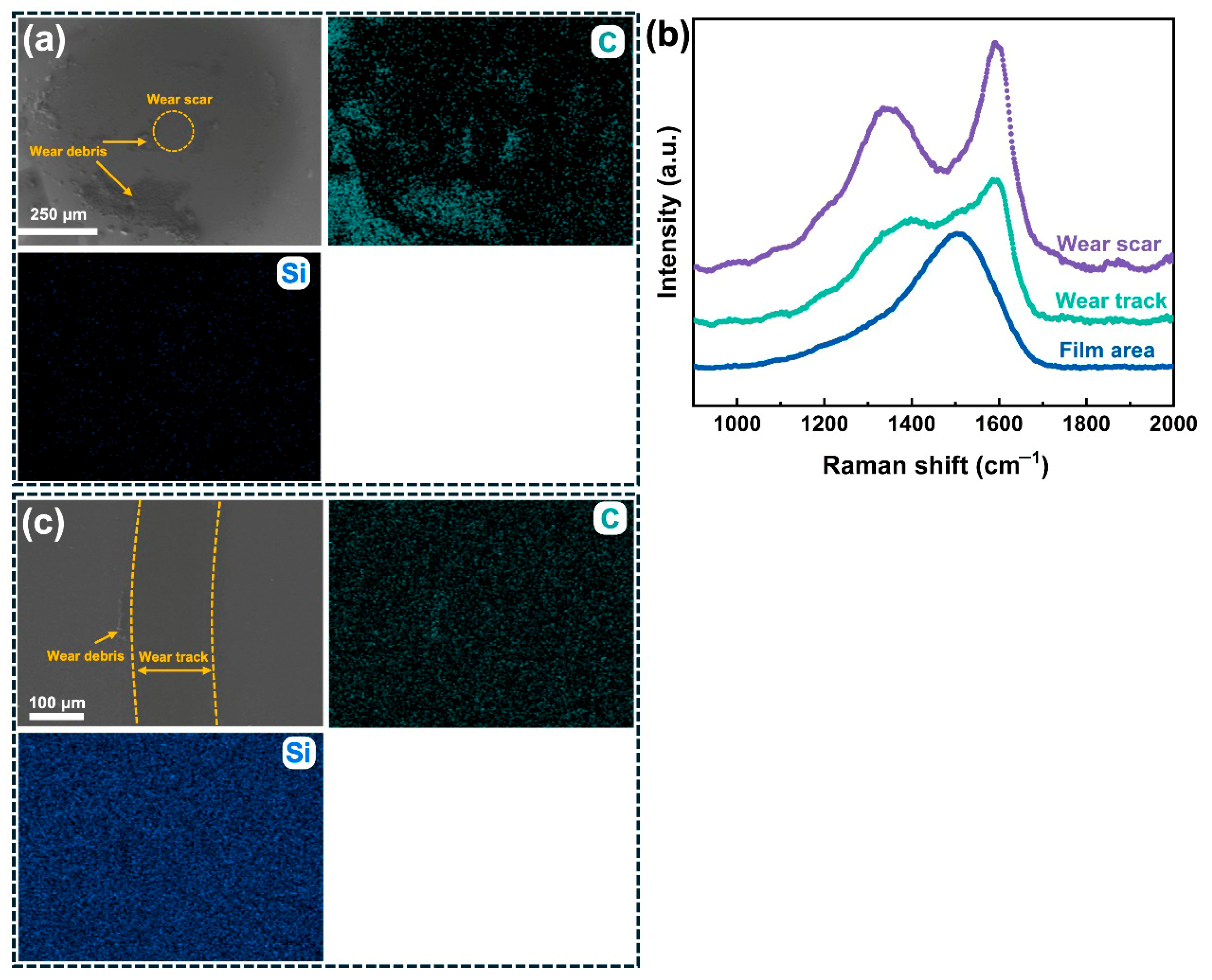

| Parameters | a-C:H:Si |
|---|---|
| Base pressure (Pa) | 5 × 10−3 |
| Working pressure (Pa) | ~0.6 |
| Ar/C2H2 ratio | 4:1 |
| Working temperature (°C) | 120 |
| Bias voltage (V) Substrate rotation (r/min) | −100 3 |
| Deposition time (min) | 120 |
| Carbon target power (W) | 1000 |
| Silicon target power (W) | 0/50/100/200 |
Disclaimer/Publisher’s Note: The statements, opinions and data contained in all publications are solely those of the individual author(s) and contributor(s) and not of MDPI and/or the editor(s). MDPI and/or the editor(s) disclaim responsibility for any injury to people or property resulting from any ideas, methods, instructions or products referred to in the content. |
© 2025 by the authors. Licensee MDPI, Basel, Switzerland. This article is an open access article distributed under the terms and conditions of the Creative Commons Attribution (CC BY) license (https://creativecommons.org/licenses/by/4.0/).
Share and Cite
Yu, Z.; Shang, J.; Wang, Q.; Zheng, H.; Mei, H.; Zhao, D.; Liu, X.; Ding, J.; Zheng, J. Influence of Si Content on the Microstructure and Properties of Hydrogenated Amorphous Carbon Films Deposited by Magnetron Sputtering Technique. Coatings 2025, 15, 793. https://doi.org/10.3390/coatings15070793
Yu Z, Shang J, Wang Q, Zheng H, Mei H, Zhao D, Liu X, Ding J, Zheng J. Influence of Si Content on the Microstructure and Properties of Hydrogenated Amorphous Carbon Films Deposited by Magnetron Sputtering Technique. Coatings. 2025; 15(7):793. https://doi.org/10.3390/coatings15070793
Chicago/Turabian StyleYu, Zhen, Jiale Shang, Qingye Wang, Haoxiang Zheng, Haijuan Mei, Dongcai Zhao, Xingguang Liu, Jicheng Ding, and Jun Zheng. 2025. "Influence of Si Content on the Microstructure and Properties of Hydrogenated Amorphous Carbon Films Deposited by Magnetron Sputtering Technique" Coatings 15, no. 7: 793. https://doi.org/10.3390/coatings15070793
APA StyleYu, Z., Shang, J., Wang, Q., Zheng, H., Mei, H., Zhao, D., Liu, X., Ding, J., & Zheng, J. (2025). Influence of Si Content on the Microstructure and Properties of Hydrogenated Amorphous Carbon Films Deposited by Magnetron Sputtering Technique. Coatings, 15(7), 793. https://doi.org/10.3390/coatings15070793






